Milnacipran hydrochloride
Editor-In-Chief: C. Michael Gibson, M.S., M.D. [1]; Associate Editor(s)-in-Chief: Gloria Picoy [2]
Disclaimer
WikiDoc MAKES NO GUARANTEE OF VALIDITY. WikiDoc is not a professional health care provider, nor is it a suitable replacement for a licensed healthcare provider. WikiDoc is intended to be an educational tool, not a tool for any form of healthcare delivery. The educational content on WikiDoc drug pages is based upon the FDA package insert, National Library of Medicine content and practice guidelines / consensus statements. WikiDoc does not promote the administration of any medication or device that is not consistent with its labeling. Please read our full disclaimer here.
Black Box Warning
|
WARNING: SUICIDALITY AND ANTIDEPRESSANT DRUGS
See full prescribing information for complete Boxed Warning.
Milnacipran hydrochloride is a selective serotonin and norepinephrine reuptake inhibitor (SNRI), similar to some drugs used for the treatment of depression and other psychiatric disorders. Antidepressants increased the risk compared to placebo of suicidal thinking and behavior (suicidality) in children, adolescents, and young adults in short-term studies of major depressive disorder (MDD) and other psychiatric disorders. Anyone considering the use of such drugs in a child, adolescent, or young adult must balance this risk with the clinical need. Short-term studies did not show an increase in the risk of suicidality with antidepressants compared to placebo in adults beyond age 24; there was a reduction in risk with antidepressants compared to placebo in adults aged 65 and older. Depression and certain other psychiatric disorders are themselves associated with increases in the risk of suicide. Patients of all ages who are started on milnacipran hydrochloride should be monitored appropriately and observed closely for clinical worsening, suicidality, or unusual changes in behavior. Families and caregivers should be advised of the need for close observation and communication with the prescriber. milnacipran hydrochloride is not approved for use in the treatment of major depressive disorder. milnacipran hydrochloride is not approved for use in pediatric patients
|
Overview
Milnacipran hydrochloride is a serotonin/norepinephrine reuptake inhibitor that is FDA approved for the treatment of fibromyalgia. There is a Black Box Warning for this drug as shown here. Common adverse reactions include nausea, headache, constipation, dizziness, insomnia, hot flush, hyperhidrosis, vomiting, palpitations, tachycardia, dry mouth, and hypertension.
Adult Indications and Dosage
FDA-Labeled Indications and Dosage (Adult)
Milnacipran hydrochloride indicated for the management of fibromyalgia.
- Dosage:
- Administer milnacipran hydrochloride in two divided doses per day.
- Based on efficacy and tolerability, dosing may be titrated according to the following schedule:
- Day 1: 12.5 mg once
- Days 2-3: 25 mg/day (12.5 mg twice daily)
- Days 4-7: 50 mg/day (25 mg twice daily)
- After Day 7: 100 mg/day (50 mg twice daily)
Off-Label Use and Dosage (Adult)
Guideline-Supported Use
There is limited information regarding Off-Label Guideline-Supported Use of Milnacipran hydrochloride in adult patients.
Non–Guideline-Supported Use
Pediatric Indications and Dosage
FDA-Labeled Indications and Dosage (Pediatric)
Safety and effectiveness of milnacipran hydrochloride for fibromyalgia not established in pediatric patients less than 17 years of age.
Off-Label Use and Dosage (Pediatric)
Guideline-Supported Use
There is limited information regarding Off-Label Guideline-Supported Use of Milnacipran hydrochloride in pediatric patients.
Non–Guideline-Supported Use
There is limited information regarding Off-Label Non–Guideline-Supported Use of Milnacipran hydrochloride in pediatric patients.
Contraindications
Monoamine Oxidase Inhibitors (MAOIs)
- The use of MAOIs intended to treat psychiatric disorders with milnacipran hydrochloride or within 5 days of stopping treatment with milnacipran hydrochloride is contraindicated because of an increased risk of serotonin syndrome.
- The use of milnacipran hydrochloride within 14 days of stopping an MAOI intended to treat psychiatric disorders is also contraindicated.
- Starting milnacipran hydrochloride in a patient who is being treated with MAOIs such as linezolid or intravenous methylene blue is also contraindicated because of an increased risk of serotonin syndrome.
Uncontrolled Narrow-Angle Glaucoma
- In clinical trials, milnacipran hydrochloride was associated with an increased risk of mydriasis.
- Mydriasis has been reported with other dual reuptake inhibitors of norepinephrine and serotonin; therefore, do not use milnacipran hydrochloride in patients with uncontrolled narrow-angle glaucoma.
Warnings
|
WARNING: SUICIDALITY AND ANTIDEPRESSANT DRUGS
See full prescribing information for complete Boxed Warning.
Milnacipran hydrochloride is a selective serotonin and norepinephrine reuptake inhibitor (SNRI), similar to some drugs used for the treatment of depression and other psychiatric disorders. Antidepressants increased the risk compared to placebo of suicidal thinking and behavior (suicidality) in children, adolescents, and young adults in short-term studies of major depressive disorder (MDD) and other psychiatric disorders. Anyone considering the use of such drugs in a child, adolescent, or young adult must balance this risk with the clinical need. Short-term studies did not show an increase in the risk of suicidality with antidepressants compared to placebo in adults beyond age 24; there was a reduction in risk with antidepressants compared to placebo in adults aged 65 and older. Depression and certain other psychiatric disorders are themselves associated with increases in the risk of suicide. Patients of all ages who are started on milnacipran hydrochloride should be monitored appropriately and observed closely for clinical worsening, suicidality, or unusual changes in behavior. Families and caregivers should be advised of the need for close observation and communication with the prescriber. milnacipran hydrochloride is not approved for use in the treatment of major depressive disorder. milnacipran hydrochloride is not approved for use in pediatric patients
|
Suicide Risk
Milnacipran hydrochloride is a selective serotonin-norepinephrine reuptake inhibitor (SNRI), similar to some drugs used for the treatment of depression and other psychiatric disorders.
Patients, both adult and pediatric, with depression or other psychiatric disorders may experience worsening of their depression and/or the emergence of suicidal ideation and behavior (suicidality) or unusual changes in behavior, whether or not they are taking these medications, and this risk may persist until significant remission occurs. Suicide is a known risk of depression and certain other psychiatric disorders, and these disorders themselves are the strongest predictors of suicide. There has been a long-standing concern, however, that antidepressants, including drugs that inhibit the reuptake of norepinephrine and/or serotonin, may have a role in inducing worsening of depression and the emergence of suicidality in certain patients during the early phases of treatment.
In the placebo-controlled clinical trials of adults with fibromyalgia, among the patients who had a history of depression at treatment initiation, the incidence of suicidal ideation was 0.5% in patients treated with placebo, 0% in patients treated with milnacipran hydrochloride 100 mg/day, and 1.3% in patients treated with milnacipran hydrochloride 200 mg/day. No suicides occurred in the short-term or longer-term (up to 1 year) fibromyalgia trials.
Pooled analyses of short-term placebo-controlled trials of drugs used to treat depression (SSRIs and others) showed that these drugs increase the risk of suicidal thinking and behavior (suicidality) in children, adolescents, and young adults (ages 18-24) with major depressive disorder (MDD) and other psychiatric disorders. Short-term studies did not show an increase in the risk of suicidality with these drugs compared to placebo in adults beyond age 24; there was a reduction in suicidality risk with antidepressants compared to placebo in adults age 65 and older.
The pooled analyses of placebo-controlled trials in children and adolescents with MDD, obsessive compulsive disorder (OCD), or other psychiatric disorders included a total of 24 short-term trials of 9 drugs used to treat depression in over 4400 patients. The pooled analyses of placebo-controlled trials in adults with MDD or other psychiatric disorders included a total of 295 short-term trials (median duration of 2 months) of 11 antidepressant drugs in over 77,000 patients.
There was considerable variation in risk of suicidality among drugs, but a tendency toward an increase in the younger patients for almost all drugs studied. There were differences in absolute risk of suicidality across the different indications, with the highest incidence in MDD. The risk of differences (drug versus placebo), however, were relatively stable within age strata and across indications. These risk differences (drug-placebo difference in the number of cases of suicidality per 1000 patients treated) are provided in TABLE 1.
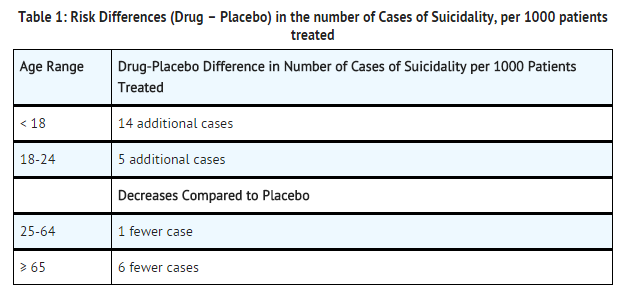
No suicides occurred in any of the pediatric trials. There were suicides in the adult trials, but the number was not sufficient to reach any conclusion about drug effect on suicide.
It is unknown whether the suicidality risk extends to longer-term use, i.e., beyond several months.
However, there is substantial evidence from placebo-controlled maintenance trials in adults with depression that the use of antidepressants can delay the recurrence of depression.
All patients being treated with drugs inhibiting the reuptake of norepinephrine and/or serotonin for any indication should be monitored appropriately and observed closely for clinical worsening, suicidality, and unusual changes in behavior, especially during the initial few months of a course of drug therapy, or at times of dose changes, either increases or decreases.
The following symptoms, anxiety, agitation, panic attacks, insomnia, irritability, hostility, aggressiveness, impulsivity, akathisia (psychomotor restlessness), hypomania, mania, have been reported in adult and pediatric patients being treated with drugs inhibiting the reuptake of norepinephrine and/or serotonin for major depressive disorder as well as for other indications, both psychiatric and nonpsychiatric. Although a causal link between the emergence of such symptoms and either the worsening of depression and/or the emergence of suicidal impulses has not been established, there is concern that such symptoms may represent precursors to emerging suicidality.
Consideration should be given to changing the therapeutic regimen, including possibly discontinuing the medication, in patients who may experience worsening depressive symptoms, or who are experiencing emergent suicidality or symptoms that might be precursors to worsening depression or suicidality, especially if these symptoms are severe or abrupt in onset, or were not part of the patient's presenting symptoms.
If the decision has been made to discontinue treatment due to worsening depressive symptoms or emergent suicidality, medication should be tapered, as rapidly as is feasible, but with recognition that abrupt discontinuation can produce withdrawal symptoms.
Families and caregivers of patients being treated with drugs inhibiting the reuptake of norepinephrine and/or serotonin for major depressive disorder or other indications, both psychiatric and nonpsychiatric, should be alerted about the need to monitor patients for the emergence of agitation, irritability, unusual changes in behavior, and the other symptoms described above, as well as the emergence of suicidality, and to report such symptoms immediately to health care providers. Such monitoring should include daily observation by families and caregivers. Prescriptions for milnacipran hydrochloride should be written for the smallest quantity of tablets consistent with good patient management, in order to reduce the risk of overdose.
Serotonin Syndrome
The development of a potentially life-threatening serotonin syndrome has been reported with SNRIs and SSRIs, including milnacipran hydrochloride, alone but particularly with concomitant use of other serotonergic drugs (including triptans, tricyclic antidepressants, fentanyl, lithium, tramadol, tryptophan, buspirone, and St. John's Wort) and with drugs that impair metabolism of serotonin (in particular MAOIs, both those intended to treat psychiatric disorders and also others, such as linezolid and intravenous methylene blue).
Serotonin syndrome symptoms may include mental status changes (e.g., agitation, hallucinations, delirium, and coma), autonomic instability (e.g., tachycardia, labile blood pressure, dizziness, diaphoresis, flushing, hyperthermia), neuromuscular symptoms (e.g., tremor, rigidity, myoclonus, hyperreflexia, incoordination), seizures, and/or gastrointestinal symptoms (e.g., nausea, vomiting, diarrhea). Patients should be monitored for the emergence of serotonin syndrome.
The concomitant use of milnacipran hydrochloride with MAOIs intended to treat psychiatric disorders is contraindicated. Milnacipran hydrochloride should also not be started in a patient who is being treated with MAOIs such as linezolid or intravenous methylene blue. All reports with methylene blue that provided information on the route of administration involved intravenous administration in the dose range of 1 mg/kg to 8 mg/kg. No reports involved the administration of methylene blue by other routes (such as oral tablets or local tissue injection) or at lower doses. There may be circumstances when it is necessary to initiate treatment with an MAOI such as linezolid or intravenous methylene blue in a patient taking milnacipran hydrochloride. milnacipran hydrochloride should be discontinued before initiating treatment with the MAOI.
If concomitant use of milnacipran hydrochloride with other serotonergic drugs including triptans, tricyclic antidepressants, fentanyl, lithium, tramadol, buspirone, tryptophan and St. John's Wort is clinically warranted, patients should be made aware of a potential increased risk for serotonin syndrome, particularly during treatment initiation and dose increases.
Treatment with milnacipran hydrochloride and any concomitant serotonergic agents should be discontinued immediately if the above events occur, and supportive symptomatic treatment should be initiated.
Elevated Blood Pressure
A double-blind, placebo-controlled ambulatory blood pressure monitoring (ABPM) study was conducted to evaluate the effects of milnacipran (up to 200 mg/day) on blood pressure in 321 fibromyalgia patients. Among fibromyalgia patients who were normotensive at baseline, an analysis of the blood pressure findings demonstrated a substantially higher proportion of milnacipran hydrochloride-treated patients had a hypertensive blood pressure measurement at the Week 4, 50 mg BID steady state visit (17.7% [n=21/119]) and the Week 7, 100 mg BID steady state visit (14.3% [n=15/105]) as compared to placebo-treated patients (3.7% [n=2/54] and 0% [0/49] at the Week 4 and Week 7 visits, respectively). Hypertension was defined as mean systolic blood pressure (SBP) ≥140 mmHg and change from baseline in mean SBP ≥10 mmHg or mean diastolic blood pressure (DBP) ≥90 mmHg and change from baseline in mean DBP ≥5 mmHg for the 12-hour period post AM study drug measurement at that visit. Furthermore, 1.9% (4/210) of milnacipran hydrochloride-treated and 0.9% (1/111) of placebo patients discontinued treatment for increases in blood pressure.
The increased risk of blood pressure measurements in the hypertensive range in milnacipran hydrochloride-treated patients is supported by substantial increases in mean SBP and DBP measurements observed in the ABPM study. TABLE 2 shows that, following treatment with milnacipran hydrochloride 50 mg BID for three weeks in patients who were normotensive at baseline, the mean increase from baseline was 5 mmHg in systolic blood pressure (SBP) and diastolic blood pressure (DBP). After further treatment with milnacipran hydrochloride 100 mg BID for two weeks, the mean increase from baseline in SBP and DBP was 6 mmHg. Similar elevations occurred in milnacipran hydrochloride-treated patients who were hypertensive at baseline.
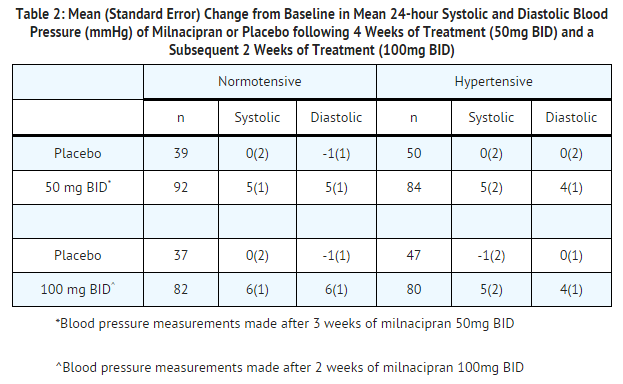
Similar patterns of treatment-emergent blood pressure elevations were observed in Phase 3 and clinical pharmacology studies as manifested by an increased risk of new onset hypertension or substantial increases in end of study blood pressure measurements in patients with hypertension at baseline.
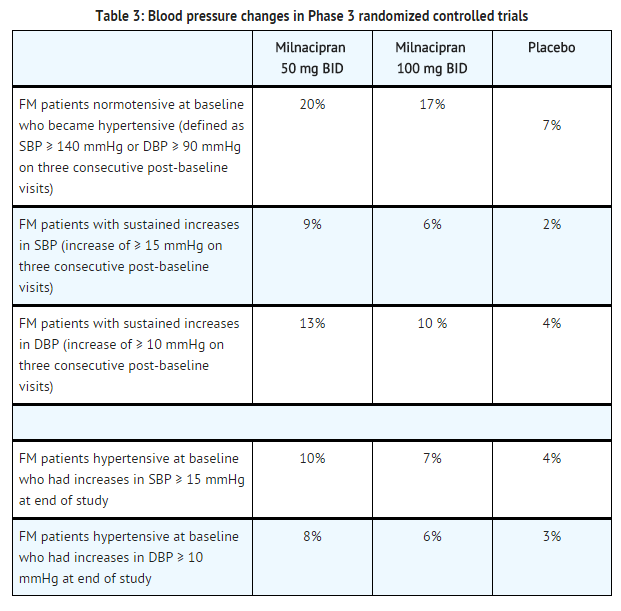
Sustained increases in blood pressure may have adverse consequences. Cases of elevated blood pressure requiring immediate treatment have been reported.
Concomitant use of milnacipran hydrochloride with drugs that increase blood pressure and heart rate has not been evaluated and such combinations should be used with caution.
Effects of milnacipran hydrochloride on blood pressure in patients with significant hypertension or cardiac disease have not been systematically evaluated. Milnacipran hydrochloride should be used with caution in these patients.
Measure blood pressure prior to initiating treatment and periodically monitor blood pressure throughout milnacipran hydrochloride treatment. Treat pre-existing hypertension and other cardiovascular disease before starting therapy with milnacipran hydrochloride. For patients who experience a sustained increase in blood pressure while receiving milnacipran hydrochloride, either reduce the dose or discontinue treatment with milnacipran hydrochloride if clinically warranted.
Tachycardia
A double-blind, placebo-controlled ABPM study was conducted to evaluate the effects of milnacipran (up to 200 mg/day) on blood pressure in 321 fibromyalgia patients. Information on heart rate was also collected. Following treatment with milnacipran hydrochloride 50mg BID for three weeks in patients who were normotensive at baseline, the mean increase in mean 24-hour heart rate from baseline was 13 beats per minute. After further treatment with milnacipran hydrochloride 100 mg BID for two weeks, the mean increase from baseline in heart rate was 13 beats per minute.
Similar trends were observed in the clinical trials where milnacipran hydrochloride treatment was associated with mean increases in heart rate of approximately 7 to 8 beats per minute.
Increases in heart rate ≥ 20 beats per minute occurred more frequently in milnacipran hydrochloride-treated patients when compared to placebo (8% in the milnacipran hydrochloride 50 mg BID and 100 mg BID treatment arms versus 0.3% in the placebo arm).
milnacipran hydrochloride has not been systematically evaluated in patients with a cardiac rhythm disorder.
Measure heart rate prior to initiating treatment and periodically monitor the heart rate throughout milnacipran hydrochloride treatment. Treat pre-existing tachyarrhythmias and other cardiac disease before starting therapy with milnacipran hydrochloride. For patients who experience a sustained increase in heart rate while receiving milnacipran hydrochloride, either reduce the dose or discontinue treatment with milnacipran hydrochloride if clinically warranted.
Seizures
milnacipran hydrochloride has not been systematically evaluated in patients with a seizure disorder. In clinical trials evaluating milnacipran hydrochloride in patients with fibromyalgia, seizures/convulsions have not been reported. However, seizures have been reported infrequently in patients treated with milnacipran hydrochloride for disorders other than fibromyalgia. Milnacipran hydrochloride should be prescribed with care in patients with a history of a seizure disorder.
Hepatotoxicity
In the placebo-controlled fibromyalgia trials, increases in the number of patients treated with milnacipran hydrochloride with mild elevations of ALT or AST (1-3 times the upper limit of normal, ULN) were observed. Increases in ALT were more frequently observed in the patients treated with milnacipran hydrochloride 100 mg/day (6%) and milnacipran hydrochloride 200 mg/day (7%), compared to the patients treated with placebo (3%). One patient receiving milnacipran hydrochloride 100 mg/day (0.2%) had an increase in ALT greater than 5 times the upper limit of normal but did not exceed 10 times the upper limit of normal. Increases in AST were more frequently observed in the patients treated with milnacipran hydrochloride 100 mg/day (3%) and milnacipran hydrochloride 200 mg/day (5%) compared to the patients treated with placebo (2%).
The increases of bilirubin observed in the fibromyalgia clinical trials were not clinically significant.
No case met the criteria of elevated ALT > 3x ULN and associated with an increase in bilirubin ≥ 2x ULN.
There have been cases of increased liver enzymes and reports of severe liver injury, including fulminant hepatitis with milnacipran from foreign postmarketing experience. In the cases of severe liver injury, there were significant underlying clinical conditions and/or the use of multiple concomitant medications. Because of underreporting, it is impossible to provide an accurate estimate of the true incidence of these reactions.
milnacipran hydrochloride should be discontinued in patients who develop jaundice or other evidence of liver dysfunction. Treatment with milnacipran hydrochloride should not be resumed unless another cause can be established.
milnacipran hydrochloride should ordinarily not be prescribed to patients with substantial alcohol use or evidence of chronic liver disease.
Discontinuation of Treatment with milnacipran hydrochloride
Withdrawal symptoms have been observed in clinical trials following discontinuation of milnacipran, as with other SNRIs and SSRIs.
During marketing of milnacipran, and other SNRIs and SSRIs, there have been spontaneous reports of adverse events indicative of withdrawal and physical dependence occurring upon discontinuation of these drugs, particularly when discontinuation is abrupt. The adverse events include the following: dysphoric mood, irritability, agitation, dizziness, sensory disturbances (e.g., paresthesias such as electric shock sensations), anxiety, confusion, headache, lethargy, emotional lability, insomnia, hypomania, tinnitus, and seizures. Although these events are generally self-limiting, some have been reported to be severe.
Patients should be monitored for these symptoms when discontinuing treatment with milnacipran hydrochloride. Milnacipran hydrochloride should be tapered and not abruptly discontinued after extended use. If intolerable symptoms occur following a decrease in the dose or upon discontinuation of treatment, then resuming the previously prescribed dose may be considered. Subsequently, the physician may continue decreasing the dose but at a more gradual rate.
Hyponatremia
Hyponatremia may occur as a result of treatment with SSRIs and SNRIs, including milnacipran hydrochloride. In many cases, this hyponatremia appears to be the result of the syndrome of inappropriate antidiuretic hormone secretion (SIADH). Cases with serum sodium lower than 110 mmol/L have been reported. Elderly patients may be at greater risk of developing hyponatremia with SNRIs, SSRIs, or milnacipran hydrochloride. Also, patients taking diuretics or who are otherwise volume-depleted may be at greater risk. Discontinuation of milnacipran hydrochloride should be considered in patients with symptomatic hyponatremia.
Signs and symptoms of hyponatremia include headache, difficulty concentrating, memory impairment, confusion, weakness, and unsteadiness, which may lead to falls. Signs and symptoms associated with more severe and/or acute cases have included hallucination, syncope, seizure, coma, respiratory arrest, and death.
Abnormal Bleeding
SSRIs and SNRIs, including milnacipran hydrochloride, may increase the risk of bleeding events. Concomitant use of aspirin, nonsteroidal anti-inflammatory drugs (NSAIDs), warfarin, and other anticoagulants may add to this risk. Case reports and epidemiological studies (case-control and cohort design) have demonstrated an association between use of drugs that interfere with serotonin reuptake and the occurrence of gastrointestinal bleeding. Bleeding events related to SSRIs and SNRIs use have ranged from ecchymoses, hematomas, epistaxis, and petechiae to life-threatening hemorrhages.
Patients should be cautioned about the risk of bleeding associated with the concomitant use of milnacipran hydrochloride and NSAIDs, aspirin, or other drugs that affect coagulation.
Activation of Mania
No activation of mania or hypomania was reported in the clinical trials evaluating effects of milnacipran hydrochloride in patients with fibromyalgia. However those clinical trials excluded patients with current major depressive episode. Activation of mania and hypomania have been reported in patients with mood disorders who were treated with other similar drugs for major depressive disorder. As with these other agents, milnacipran hydrochloride should be used cautiously in patients with a history of mania.
Patients with a History of Dysuria
Because of their noradrenergic effect, SNRIs including milnacipran hydrochloride, can affect urethral resistance and micturition. In the controlled fibromyalgia trials, dysuria occurred more frequently in patients treated with milnacipran hydrochloride (1%) than in placebo-treated patients (0.5%). Caution is advised in use of milnacipran hydrochloride in patients with a history of dysuria, notably in male patients with prostatic hypertrophy, prostatitis, and other lower urinary tract obstructive disorders. Male patients are more prone to genitourinary adverse effects, such as dysuria or urinary retention, and may experience testicular pain or ejaculation disorders.
Controlled Narrow-Angle Glaucoma
Mydriasis has been reported in association with SNRIs and milnacipran hydrochloride; therefore, milnacipran hydrochloride should be used cautiously in patients with controlled narrow-angle glaucoma.
Adverse Reactions
Clinical Trials Experience
Because clinical trials are conducted under widely varying conditions, adverse reaction rates observed in the clinical trials of a drug cannot be directly compared to rates in the clinical trials of another drug and may not reflect the rates observed in practice.
Patient Exposure
Milnacipran hydrochloride was evaluated in three double-blind placebo-controlled trials involving 2209 fibromyalgia patients (1557 patients treated with milnacipran hydrochloride and 652 patients treated with placebo) for a treatment period up to 29 weeks.
The stated frequencies of adverse reactions represent the proportion of individuals who experienced, at least once, a treatment-emergent adverse reaction of the type listed. A reaction was considered treatment emergent if it occurred for the first time or worsened while receiving therapy following baseline evaluation.
Adverse Reactions Leading to Discontinuation
In placebo-controlled trials in patients with fibromyalgia, 23% of patients treated with milnacipran hydrochloride
100 mg/day, 26% of patients treated with milnacipran hydrochloride 200 mg/day discontinued prematurely due to adverse reactions, compared to 12% of patients treated with placebo. The adverse reactions that led to withdrawal in ≥ 1% of patients in the milnacipran hydrochloride treatment group and with an incidence rate greater than that in the placebo treatment group were nausea (milnacipran 6%, placebo 1%), palpitations (milnacipran 3%, placebo 1%), headache (milnacipran 2%, placebo 0%), constipation (milnacipran 1%, placebo 0%), tachycardia (milnacipran 1%, placebo 0%), hyperhidrosis (milnacipran 1%, placebo 0%), vomiting (milnacipran 1%, placebo 0%), and dizziness (milnacipran 1% and placebo 0.5%). Discontinuation due to adverse reactions was generally more common among patients treated with milnacipran hydrochloride 200 mg/day compared to milnacipran hydrochloride 100 mg/day.
Most Common Adverse Reactions in Placebo Controlled Trials
In the placebo-controlled fibromyalgia patient trials, the most frequently occurring adverse reaction in clinical trials was nausea. The most common adverse reactions (incidence ≥ 5% and twice placebo) in patients treated with milnacipran hydrochloride were constipation, hot flush, hyperhidrosis, vomiting, palpitations, tachycardia, dry mouth, and hypertension.
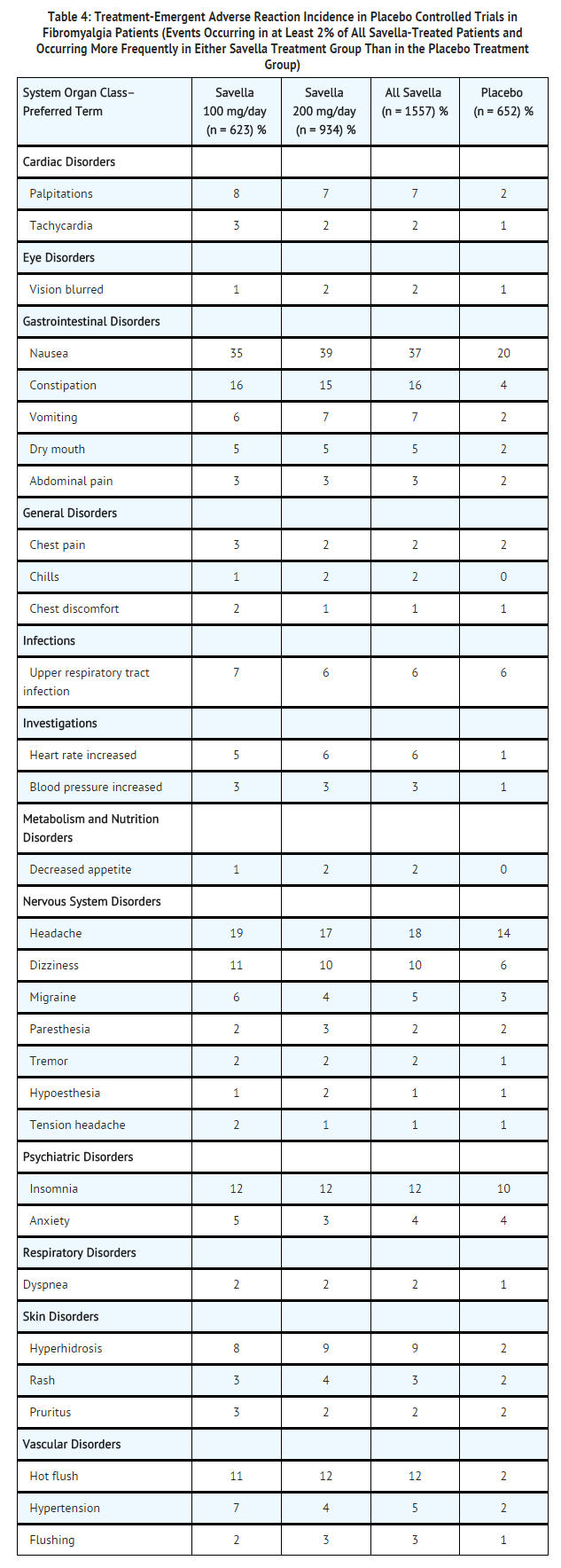
Weight Changes
In placebo-controlled fibromyalgia clinical trials, patients treated with milnacipran hydrochloride for up to 3 months experienced a mean weight loss of approximately 0.8 kg in both the milnacipran hydrochloride 100 mg/day and the milnacipran hydrochloride 200 mg/day treatment groups, compared with a mean weight loss of approximately 0.2 kg in placebo-treated patients.
Genitourinary Adverse Reactions in Males
In the placebo-controlled fibromyalgia studies, the following treatment-emergent adverse reactions related to the genitourinary system were observed in at least 2% of male patients treated with milnacipran hydrochloride, and occurred at a rate greater than in placebo-treated male patients: dysuria, ejaculation disorder, erectile dysfunction, ejaculation failure, libido decreased, prostatitis, scrotal pain, testicular pain, testicular swelling, urinary hesitation, urinary retention, urethral pain, and urine flow decreased.
Other Adverse Reactions Observed During Clinical Trials of milnacipran hydrochloride in Fibromyalgia
Following is a list of frequent (those occurring on one or more occasions in at least 1/100 patients) treatment-emergent adverse reactions reported from 1824 fibromyalgia patients treated with milnacipran hydrochloride for periods up to 68 weeks. The listing does not include those events already listed in TABLE 4, those events for which a drug cause was remote, those events which were so general as to be uninformative, and those events reported only once which did not have a substantial probability of being acutely life threatening.
Adverse reactions are categorized by body system and listed in order of decreasing frequency.
- Gastrointestinal Disorders: diarrhea, dyspepsia, gastroesophageal reflux disease, flatulence, abdominal distension
- General Disorders: fatigue, peripheral edema, irritability, pyrexia
- Infections: urinary tract infection, cystitis
- Injury, Poisoning, and Procedural Complications: contusion, fall
- Investigations: weight decreased or increased
- Metabolism and Nutrition Disorders: hypercholesterolemia
- Nervous System Disorders: somnolence, dysgeusia
- Psychiatric Disorders: depression, stress
- Skin Disorders: night sweats
Postmarketing Experience
The following additional adverse reactions have been identified from spontaneous reports of milnacipran hydrochloride received worldwide. These adverse reactions have been chosen for inclusion because of a combination of seriousness, frequency of reporting, or potential causal connection to milnacipran hydrochloride. However, because these adverse reactions were reported voluntarily from a population of uncertain size, it is not always possible to reliably estimate their frequency or establish a causal relationship to drug exposure. These events include:
- Blood and Lymphatic System Disorders: leukopenia, neutropenia, thrombocytopenia
- Cardiac Disorders: supraventricular tachycardia
- Eye Disorders: accommodation disorder
- Endocrine Disorders: hyperprolactinemia
- Hepatobiliary Disorders: hepatitis
- Metabolism and Nutrition Disorders: anorexia, hyponatremia
- Musculoskeletal and Connective Tissue Disorders: rhabdomyolysis
- Nervous System Disorders: convulsions (including grand mal), loss of consciousness, Parkinsonism
- Psychiatric Disorders: aggression, anger, delirium, hallucination, homicidal ideation
- Renal and Urinary Disorders: acute renal failure
- Reproductive System and Breast Disorders: galactorrhea
- Skin Disorders: erythema multiforme, Stevens Johnson syndrome
- Vascular Disorders: hypertensive crisis
Drug Interactions
Milnacipran undergoes minimal CYP450 related metabolism, with the majority of the dose excreted unchanged in urine (55%), and has a low binding to plasma proteins (13%). In vitro and in vivo studies showed that milnacipran hydrochloride is unlikely to be involved in clinically significant pharmacokinetic drug interactions.
Monoamine Oxidase Inhibitors (MAOIs)
Serotonergic Drugs
Triptans
There have been rare postmarketing reports of serotonin syndrome with use of an SSRI and a triptan. If concomitant treatment of milnacipran hydrochloride with a triptan is clinically warranted, careful observation of the patient is advised, particularly during treatment initiation and dose increases.
Catecholamines
milnacipran hydrochloride inhibits the reuptake of norepinephrine. Therefore concomitant use of milnacipran hydrochloride with epinephrine and norepinephrine may be associated with paroxysmal hypertension and possible arrhythmia.
CNS-active drugs
Given the primary CNS effects of milnacipran hydrochloride, caution should be used when it is taken in combination with other centrally acting drugs, including those with a similar mechanism of action.
Clomipramine: In a drug-drug interaction study, an increase in euphoria and postural hypotension was observed in patients who switched from clomipramine to milnacipran hydrochloride.
Clinically Important Interactions with Select Cardiovascular Agents
Digoxin: Use of milnacipran hydrochloride concomitantly with digoxin may be associated with potentiation of adverse hemodynamic effects. Postural hypotension and tachycardia have been reported in combination therapy with intravenously administered digoxin (1 mg). Co-administration of milnacipran hydrochloride and intravenous digoxin should be avoided.
Clonidine: Because milnacipran hydrochloride inhibits norepinephrine reuptake, co-administration with clonidine may inhibit clonidine's anti-hypertensive effect.
Use in Specific Populations
Pregnancy
Risk Summary
There are no adequate or well-controlled studies in pregnant women. Neonates exposed to dual reuptake inhibitors of serotonin and norepinephrine (such as milnacipran hydrochloride), or selective serotonin reuptake inhibitors late in the third trimester have developed complications that can arise immediately upon delivery. Reproduction studies have been performed in rats, rabbits and mice. Milnacipran was shown to increase embryo fetal and perinatal lethality in rats and the incidence of a minor skeletal variation in rabbits at doses below (rat) or approximately equal to (rabbit) the maximum recommended human dose (MRHD) of 200 mg/day on a mg/m2 basis. No effects were seen in mice when treated with milnacipran during the period of organogenesis at doses up to 3 times the MHRD on a mg/m2 basis. Because animal reproduction studies are not always predictive of human response, milnacipran hydrochloride should be used during pregnancy only if the potential benefit justifies the potential risk to the fetus.
Pregnancy Registry
Physicians are advised to recommend that pregnant patients taking milnacipran hydrochloride enroll in the milnacipran hydrochloride Pregnancy Registry.
Clinical Consideration
Neonates exposed to dual reuptake inhibitors of serotonin and norepinephrine, or selective serotonin reuptake inhibitors late in the third trimester have developed complications that can arise immediately upon delivery and require prolonged hospitalization, respiratory support, and tube feeding. Such complications can arise immediately upon delivery. Monitor neonates for reported clinical findings such as respiratory distress, cyanosis, apnea, seizures, temperature instability, feeding difficulty, vomiting, hypoglycemia, hypotonia, hypertonia, hyperreflexia, tremor, jitteriness, irritability, and constant crying. These features are consistent with either a direct toxic effect of these classes of drugs or, possibly, a drug discontinuation syndrome. It should be noted that, in some cases, the clinical picture is consistent with serotonin syndrome.
Animal Data
Studies were conducted in rats, rabbits and mice with dosing of milnacipran during the period of organogenesis. In rats, milnacipran was shown to increase embryo fetal lethality at doses of 5 mg/kg/day (0.25 times the MRHD on a mg/m2 basis). In rabbits, dose-dependent increases in the incidence of the skeletal variation of an extra single rib were observed in several pups from multiple litters in the absence of maternal toxicity at 15 mg/kg/day (1.5 times the MRHD on a mg/m2 basis). The clinical significance of this finding is unknown. In mice, no embryotoxic or teratogenic effects were seen at doses up to 125 mg/kg/day (3 times the MHRD on a mg/m2 basis).
With peri- and postnatal exposure to oral milnacipran in rats, decreases in viability and body weight were observed on Postpartum Day 4 at a dose of 5 mg/kg/day (approximately 0.25 times the MRHD on a mg/m2 basis). The no-effect dose for maternal and offspring toxicity was 2.5 mg/kg/day (approximately 0.1 times the MRHD on a mg/m2 basis).
Pregnancy Category (AUS): B3
There is no Australian Drug Evaluation Committee (ADEC) guidance on usage of Milnacipran hydrochloride in women who are pregnant.
Labor and Delivery
There is no FDA guidance on use of Milnacipran hydrochloride during labor and delivery.
Nursing Mothers
Milnacipran is present in the milk of lactating women treated with milnacipran hydrochloride. In a pharmacokinetic study, a single, oral dose of 50 mg milnacipran HCl tablet was administered to 8 lactating women who were at least 12 weeks postpartum and weaning their infants. The maximum estimated daily infant dose for milnacipran from breast milk (assuming mean milk consumption of 150 mL/kg/day) was 5% of the maternal dose based on peak plasma concentrations. In most patients, peak concentrations of milnacipran in breast milk were seen within 4 hours after the maternal dose. Because of the limited data regarding infant exposure to milnacipran hydrochloride, caution should be exercised when milnacipran hydrochloride is administered to a nursing woman.
Pediatric Use
Safety and effectiveness of milnacipran hydrochloride in a fibromyalgia pediatric population below the age of 18 have not been established.
Geriatic Use
In controlled clinical studies of milnacipran hydrochloride, 402 patients were 60 years or older, and no overall differences in safety and efficacy were observed between these patients and younger patients.
In view of the predominant excretion of unchanged milnacipran via kidneys and the expected decrease in renal function with age, renal function should be considered prior to use of milnacipran hydrochloride in the elderly.
SNRIs, SSRIs, and milnacipran hydrochloride, have been associated with cases of clinically significant hyponatremia in elderly patients, who may be at greater risk for this adverse event.
Gender
Cmax and AUC parameters of milnacipran were about 20% higher in female subjects compared with male subjects. Dosage adjustment based on gender is not necessary.
Race
There is no FDA guidance on the use of Milnacipran hydrochloride with respect to specific racial populations.
Renal Impairment
Milnacipran pharmacokinetics were evaluated following single oral administration of 50 mg milnacipran hydrochloride to subjects with mild (creatinine clearance [CLcr] 50-80 mL/min), moderate (CLcr 30-49 mL/min), and severe (CLcr 5-29 mL/min) renal impairment and to healthy subjects (CLcr > 80 mL/min). The mean AUC0-∞ increased by 16%, 52%, and 199%, and terminal elimination half-life increased by 38%, 41%, and 122% in subjects with mild, moderate, and severe renal impairment, respectively, compared with healthy subjects.
No dosage adjustment is necessary for patients with mild renal impairment. Caution should be exercised in patients with moderate renal impairment. Dose adjustment is necessary in severe renal impairment patients
Hepatic Impairment
Milnacipran pharmacokinetics were evaluated following single oral administration of 50 mg milnacipran hydrochloride to subjects with mild (Child-Pugh A), moderate (Child-Pugh B), and severe (Child-Pugh C) hepatic impairment and to healthy subjects. AUC0-∞ and T½ were similar in healthy subjects and subjects with mild and moderate hepatic impairment. However, subjects with severe hepatic impairment had a 31% higher AUC0-∞ and a 55% higher T½ than healthy subjects. Caution should be exercised in patients with severe hepatic impairment.
Females of Reproductive Potential and Males
Although administration of milnacipran to male and female rats had no statistically significant effect on mating or fertility at doses up to 80 mg/kg/day (4 times the MRHD on an mg/m2 basis), there was an apparent dose-related decrease in the fertility index at clinically relevant doses based on body surface area.
Immunocompromised Patients
There is no FDA guidance one the use of Milnacipran hydrochloride in patients who are immunocompromised.
Administration and Monitoring
Administration
Oral
Monitoring
There is limited information regarding Milnacipran hydrochloride Monitoring in the drug label.
IV Compatibility
There is limited information regarding the compatibility of Milnacipran hydrochloride and IV administrations.
Overdosage
There is limited clinical experience with milnacipran hydrochloride overdose in humans. In clinical trials, cases of acute ingestions up to 1000 mg, alone or in combination with other drugs, were reported with none being fatal.
In postmarketing experience, fatal outcomes have been reported for acute overdoses primarily involving multiple drugs but also with milnacipran hydrochloride only. The most common signs and symptoms included increased blood pressure, cardio-respiratory arrest, changes in the level of consciousness (ranging from somnolence to coma), confusional state, dizziness, and increased hepatic enzymes.
Management of Overdose
There is no specific antidote to milnacipran hydrochloride, but if serotonin syndrome ensues, specific treatment (such as with cyproheptadine and/or temperature control) may be considered. In case of acute overdose, treatment should consist of those general measures employed in the management of overdose with any drug.
An adequate airway, oxygenation, and ventilation should be assured and cardiac rhythm and vital signs should be monitored. Induction of emesis is not recommended. Gastric lavage with a large-bore orogastric tube with appropriate airway protection, if needed, may be indicated if performed soon after ingestion or in symptomatic patients. Because there is no specific antidote for milnacipran hydrochloride, symptomatic care and treatment with gastric lavage and activated charcoal should be considered as soon as possible for patients who experience a milnacipran hydrochloride overdose.
Due to the large volume of distribution of this drug, forced diuresis, dialysis, hemoperfusion, and exchange transfusion are unlikely to be beneficial.
In managing overdose, the possibility of multiple drug involvement should be considered. The physician should consider contacting a poison control center for additional information on the treatment of any overdose. Telephone numbers for certified poison control centers are listed in the Physicians' Desk Reference (PDR).
Pharmacology
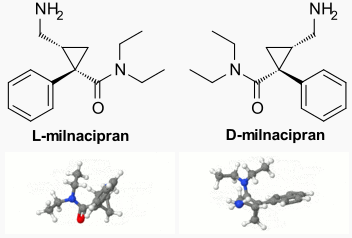
| |
Milnacipran
| |
| Systematic (IUPAC) name | |
| (1R*,2S*)-2-(aminomethyl)-N,N-diethyl-1-phenylcyclopropanecarboxamide | |
| Identifiers | |
| CAS number | |
| ATC code | N06 |
| PubChem | |
| DrugBank | |
| Chemical data | |
| Formula | Template:OrganicBox atomTemplate:OrganicBox atomTemplate:OrganicBoxTemplate:OrganicBoxTemplate:OrganicBoxTemplate:OrganicBoxTemplate:OrganicBoxTemplate:OrganicBoxTemplate:OrganicBoxTemplate:OrganicBoxTemplate:OrganicBoxTemplate:OrganicBoxTemplate:OrganicBoxTemplate:OrganicBox atomTemplate:OrganicBoxTemplate:OrganicBox atomTemplate:OrganicBoxTemplate:OrganicBoxTemplate:OrganicBoxTemplate:OrganicBoxTemplate:OrganicBoxTemplate:OrganicBoxTemplate:OrganicBox |
| Mol. mass | 246.348 g/mol |
| SMILES | & |
| Pharmacokinetic data | |
| Bioavailability | 85% |
| Protein binding | 13% |
| Metabolism | Hepatic |
| Half life | 8 hours |
| Excretion | Renal |
| Therapeutic considerations | |
| Pregnancy cat. | |
| Legal status |
Prescription Only (S4)(AU) ?(CA) POM(UK) [[Prescription drug|Template:Unicode-only]](US) |
| Routes | Oral |
Mechanism of Action
The exact mechanism of the central pain inhibitory action of milnacipran and its ability to improve the symptoms of fibromyalgia in humans are unknown. Preclinical studies have shown that milnacipran is a potent inhibitor of neuronal norepinephrine and serotonin reuptake; milnacipran inhibits norepinephrine uptake with approximately 3-fold higher potency in vitro than serotonin without directly affecting the uptake of dopamine or other neurotransmitters. Milnacipran has no significant affinity for serotonergic (5-HT1-7), α- and β-adrenergic, muscarinic (M1-5), histamine (H1-4), dopamine (D1-5), opiate, benzodiazepine, and γ-aminobutyric acid (GABA) receptors in vitro. Pharmacologic activity at these receptors is hypothesized to be associated with the various anticholinergic, sedative, and cardiovascular effects seen with other psychotropic drugs.
Milnacipran has no significant affinity for Ca++, K+, Na+ and Cl– channels and does not inhibit the activity of human monoamine oxidases (MAO-A and MAO-B) or acetylcholinesterase.
Structure
It is a racemic mixture with the chemical name: (±)-[1R(S),2S(R)]-2-(aminomethyl)-N,N-diethyl-1-phenylcyclopropanecarboxamide hydrochloride. The structural formula is:
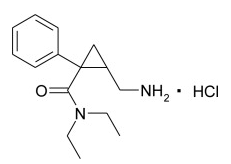
Pharmacodynamics
Cardiovascular Electrophysiology: The effect of milnacipran hydrochloride on the QTcF interval was measured in a double-blind placebo- and positive-controlled parallel study in 88 healthy subjects using 600 mg/day milnacipran hydrochloride (3 to 6 times the recommended therapeutic dose for fibromyalgia). After baseline and placebo adjustment, the maximum mean QTcF change was 8 ms (2-sided 90% CI, 3-12 ms). This increase is not considered to be clinically significant.
Pharmacokinetics
Milnacipran is well absorbed after oral administration with an absolute bioavailability of approximately 85% to 90%. The exposure to milnacipran increased proportionally within the therapeutic dose range. It is excreted predominantly unchanged in urine (55%) and has a terminal elimination half-life of about 6 to 8 hours. Steady-state levels are reached within 36 to 48 hours and can be predicted from single-dose data. The active enantiomer, d-milnacipran, has a longer elimination half-life (8-10 hours) than the l-enantiomer (4-6 hours). There is no interconversion between the enantiomers.
Absorption and Distribution
- Milnacipran hudrochloride is absorbed following oral administration with maximum concentrations (Cmax) reached within 2 to 4 hours post dose. Absorption of milnacipran hydrochloride is not affected by food. The absolute bioavailability is approximately 85% to 90%. The mean volume of distribution of milnacipran following a single intravenous dose to healthy subjects is approximately 400 L.
- Plasma protein binding is 13%.
Metabolism and Elimination
Milnacipran and its metabolites are eliminated primarily by renal excretion. Following oral administration of 14C-milnacipran hydrochloride, approximately 55% of the dose was excreted in urine as unchanged milnacipran (24% as l-milnacipran and 31% as d-milnacipran). The l-milnacipran carbamoyl-O-glucuronide was the major metabolite excreted in urine and accounted for approximately 17% of the dose; approximately 2% of the dose was excreted in urine as d-milnacipran carbamoyl-O-glucuronide. Approximately 8% of the dose was excreted in urine as the N-desethyl milnacipran metabolite.
Nonclinical Toxicology
Controlled Substance
Milnacipran is not a controlled substance.
Abuse
Milnacipran did not produce behavioral signs indicative of abuse potential in animal or human studies.
Dependence
Milnacipran produces physical dependence, as evidenced by the emergence of withdrawal symptoms following drug discontinuation, similar to other SNRIs and SSRIs. These withdrawal symptoms can be severe. Thus, milnacipran hydrochloride should be tapered and not abruptly discontinued after extended use.
Carcinogenesis
Dietary administration of milnacipran to rats at doses of 50 mg/kg/day (2 times the MRHD on a mg/m2 basis) for 2 years caused a statistically significant increase in the incidence of thyroid C-cell adenomas and combined adenomas and carcinomas in males. A carcinogenicity study was conducted in Tg.rasH2 mice for 6 months at oral gavage doses of up to 125 mg/kg/day.
Milnacipran did not induce tumors in Tg.rasH2 mice at any dose tested.
Mutagenesis
Milnacipran was not mutagenic in the in vitro bacterial reverse mutation assay (Ames test) or in the L5178Y TK +/- mouse lymphoma forward mutation assay. Milnacipran was also not clastogenic in an in vitro chromosomal aberration test in human lymphocytes or in the in vivo mouse micronucleus assay.
Animal Toxicology and/or Pharmacology
Hepatic Effects: Chronic administration (2 years) of milnacipran to rats at 15 mg/kg (0.6 times the MRHD on an mg/m2 basis) and higher doses showed increased incidences of centrilobular vacuolation of the liver in male rats and eosinophilic foci in male and female rats in the absence of any change in hepatic enzymes. The clinical significance of the finding is not known. Chronic (1 year) administration in the primate at doses up to 25 mg/kg (2 times the MRHD on a mg/m2 basis) did not demonstrate similar evidence of hepatic changes.
Ocular Effects: Chronic (2 years) administration of milnacipran to rats at 15 mg/kg (0.6 times the MRHD on a mg/m2 basis) and higher doses showed increased incidence of keratitis of the eye. One-year studies in the rat and primate did not show this response.
Clinical Studies
Management of Fibromyalgia
The efficacy of milnacipran hydrochloride for the management of fibromyalgia was established in two double-blind, placebo-controlled, multicenter studies in adult patients (18-74 years of age). Enrolled patients met the American College of Rheumatology (ACR) criteria for fibromyalgia (a history of widespread pain for 3 months and pain present at 11 or more of the 18 specific tender point sites). Approximately 35% of patients had a history of depression. Study 1 was six months in duration and Study 2 was three months in duration.
A larger proportion of patients treated with milnacipran hydrochloride than with placebo experienced a simultaneous reduction in pain from baseline of at least 30% (VAS) and also rated themselves as much improved or very much improved based on the patient global assessment (PGIC). In addition, a larger proportion of patients treated with milnacipran hydrochloride met the criteria for treatment response, as measured by the composite endpoint that concurrently evaluated improvement in pain (VAS), physical function (SF-36 PCS), and patient global assessment (PGIC), in fibromyalgia as compared to placebo.
Study 1: This 6-month study compared total daily doses of milnacipran hydrochloride 100 mg and 200 mg to placebo. Patients were enrolled with a minimum mean baseline pain score of ≥ 50 mm on a 100 mm visual analog scale (VAS) ranging from 0 (“no pain”) to 100 (“worst possible pain”). The mean baseline pain score in this trial was 69. The efficacy results for Study 1 are summarized in FIGURE 1.
FIGURE 1 shows the proportion of patients achieving various degrees of improvement in pain from baseline to the 3-month time point and who concurrently rated themselves globally improved (PGIC score of 1 or 2). Patients who did not complete the 3-month assessment were assigned 0% improvement. More patients in the milnacipran hydrochloride treatment arms experienced at least a 30% reduction in pain from baseline (VAS) and considered themselves globally improved (PGIC) than did patients in the placebo arm. Treatment with milnacipran hydrochloride 200 mg/day did not confer greater benefit than treatment with milnacipran hydrochloride 100 mg/day.
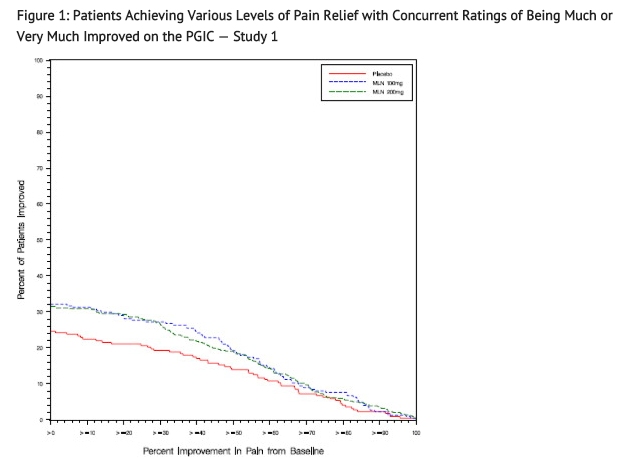
Study 2: This 3-month study compared total daily doses of milnacipran hydrochloride 100 mg and 200 mg to placebo. Patients were enrolled with a minimum mean baseline pain score of ≥ 40 mm on a 100-mm VAS ranging from 0 (“no pain”) to 100 (“worst possible pain”). The mean baseline pain score in this trial was 65. The efficacy results for Study 2 are summarized in FIGURE 2.
FIGURE 2 shows the proportion of patients achieving various degrees of improvement in pain from baseline to the 3-month time point and who concurrently rated themselves globally improved (PGIC score of 1 or 2). Patients who did not complete the 3-month assessment were assigned 0% improvement. More patients in the milnacipran hydrochloride treatment arms experienced at least a 30% reduction in pain from baseline (VAS) and considered themselves globally improved (PGIC) than did patients in the placebo arm. Treatment with milnacipran hydrochloride 200 mg/day did not confer greater benefit than treatment with milnacipran hydrochloride 100 mg/day.

In both studies, some patients who rated themselves as globally “much” or “very much” improved experienced a decrease in pain as early as week 1 of treatment with a stable dose of milnacipran hydrochloride that persisted throughout these studies.
How Supplied
- Milnacipran hydrochloride 12.5 mg tablets:
- Bottles of 60
- NDC 0456-1512-60
- Milnacipran hydrochloride 25 mg tablets:
- Bottles of 60
- NDC 0456-1525-60
- Milnacipran hydrochloride 50 mg tablets:
- Bottles of 60
- NDC 0456-1550-60
- Milnacipran hydrochloride 100 mg tablets:
- Bottles of 60
- NDC 0456-1510-60
Storage
Store at 25°C (77°F)
Images
Drug Images
{{#ask: Page Name::Milnacipran hydrochloride |?Pill Name |?Drug Name |?Pill Ingred |?Pill Imprint |?Pill Dosage |?Pill Color |?Pill Shape |?Pill Size (mm) |?Pill Scoring |?NDC |?Drug Author |format=template |template=DrugPageImages |mainlabel=- |sort=Pill Name }}
Package and Label Display Panel
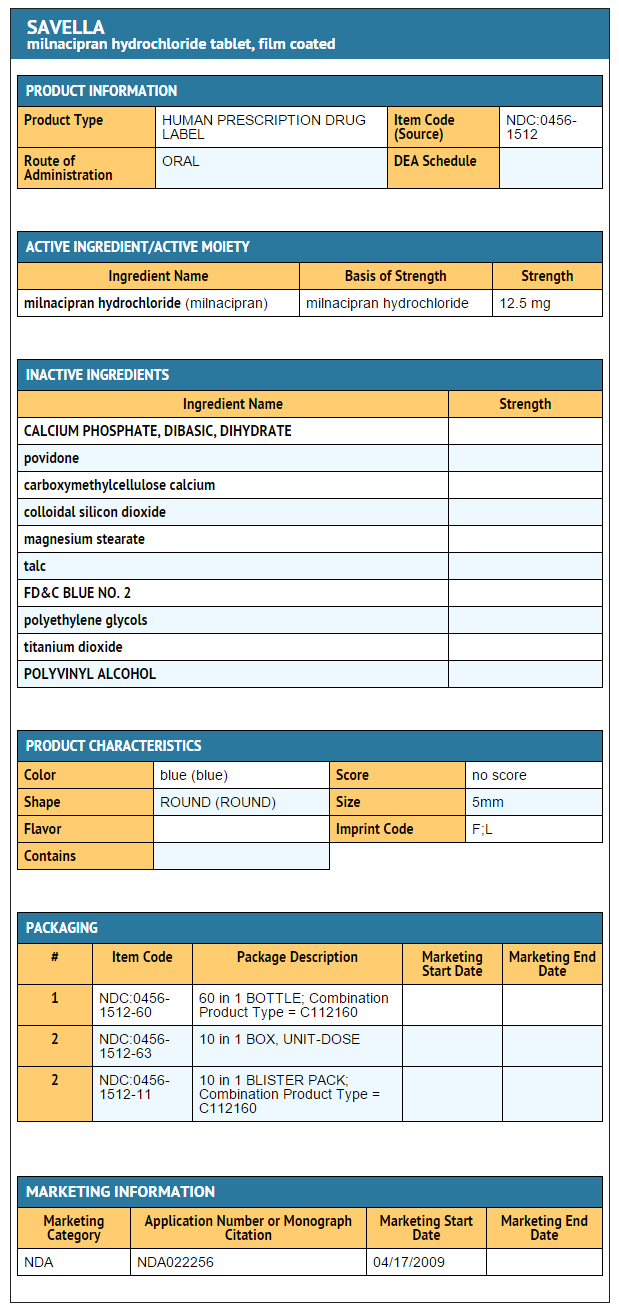
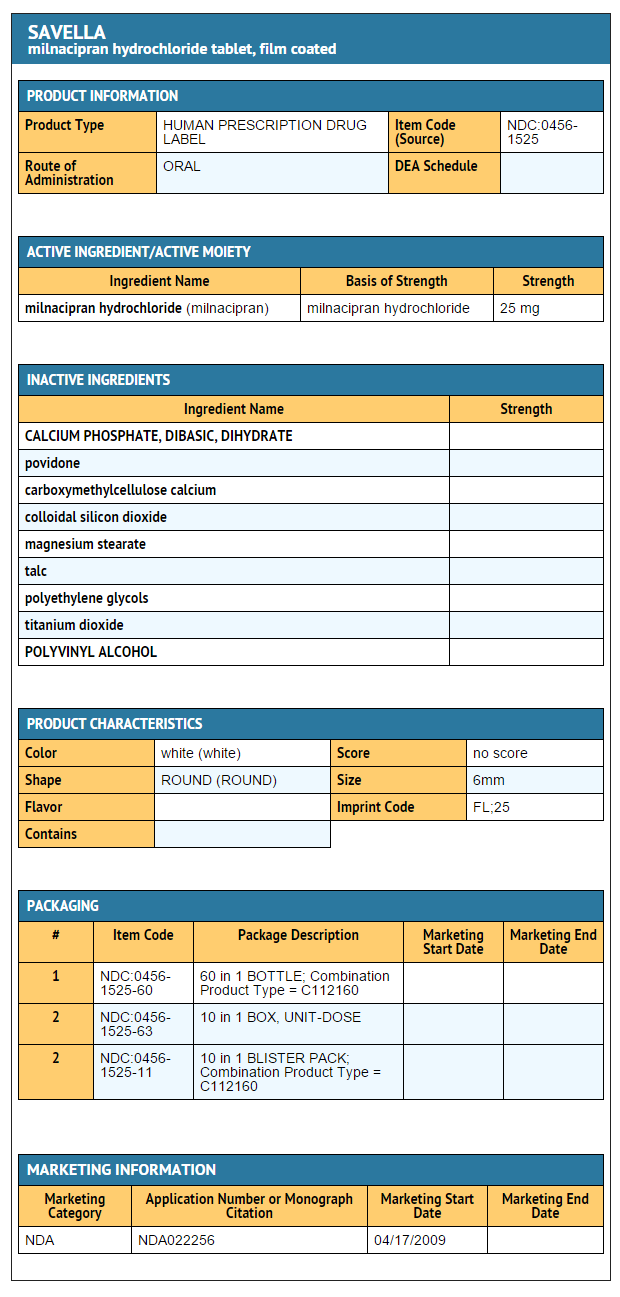
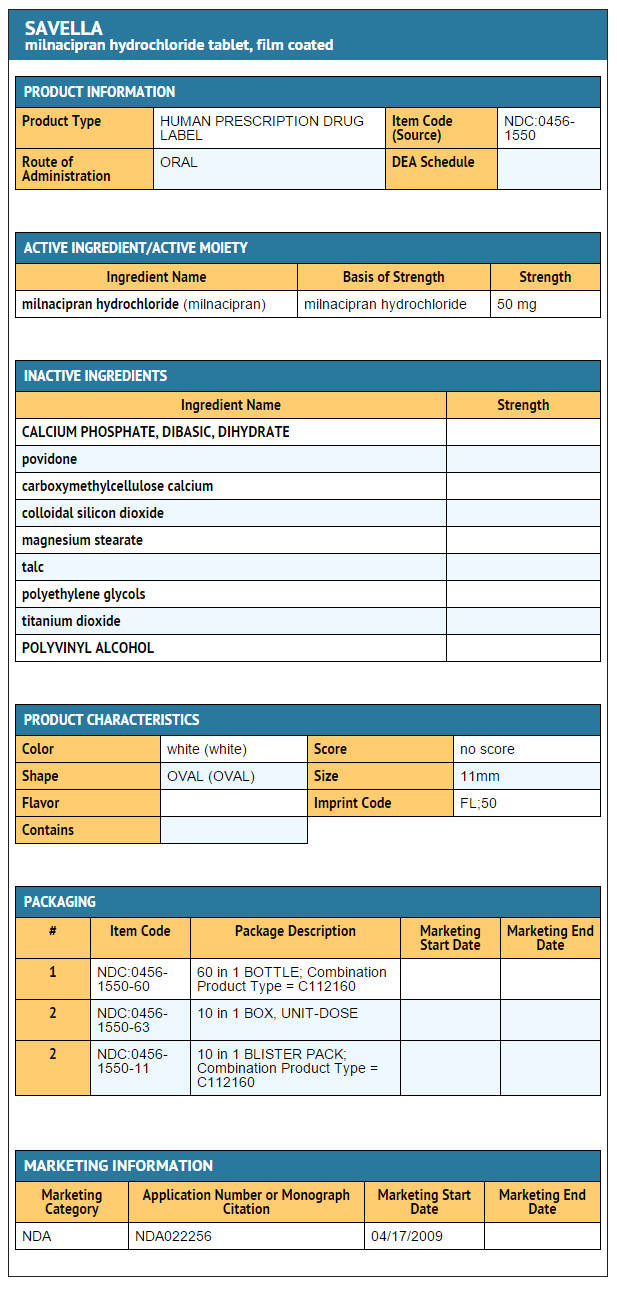
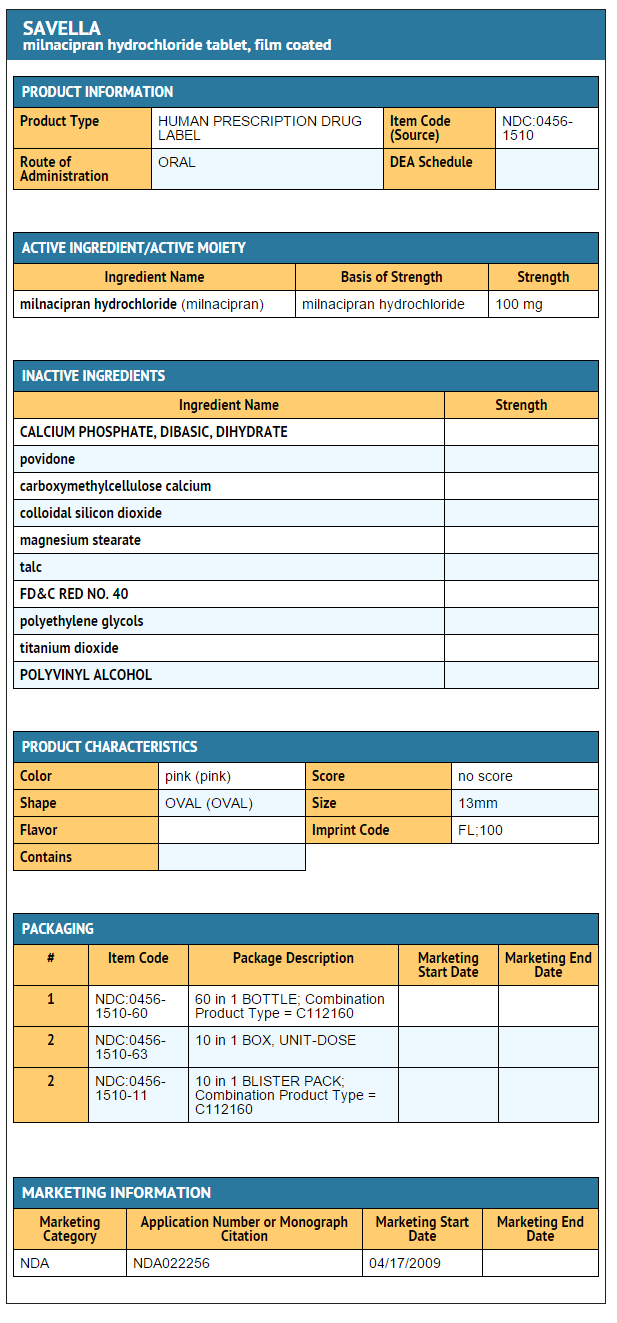
{{#ask: Label Page::Milnacipran hydrochloride |?Label Name |format=template |template=DrugLabelImages |mainlabel=- |sort=Label Page }}
Patient Counseling Information
Prescribers or other health professionals should inform patients, their families, and their caregivers about the benefits and risks associated with treatment with milnacipran hydrochloride and should counsel them in its appropriate use. A patient Medication Guide is available for milnacipran hydrochloride. The prescriber or health professional should instruct patients, their families, and their caregivers to read the Medication Guide and should assist them in understanding its contents. Patients should be given the opportunity to discuss the contents of the Medication Guide and to obtain answers to any questions they may have. The complete text of the Medication Guide is reprinted at the end of this document.
Patients should be advised of the following issues and asked to alert their prescriber if these occur while taking milnacipran hydrochloride:
Clinical Worsening and Suicide Risk
Patients and their families and caregivers should be advised that milnacipran hydrochloride is a selective norepinephrine and serotonin reuptake inhibitor and therefore belongs to the same class of drugs as antidepressants. Patients, their families, and their caregivers should be advised that patients with depression may be at increased risk for clinical worsening and/or suicidal ideation if they stop taking anti-depressant medication, change the dose, or start a new medication.
Patients, their families, and their caregivers should be encouraged to be alert to the emergence of anxiety, agitation, panic attacks, insomnia, irritability, hostility, aggressiveness, impulsivity, akathisia (psychomotor restlessness), hypomania, or other unusual changes in behavior, worsening of depression, and suicidal ideation, especially early during treatment with milnacipran hydrochloride or other drugs that inhibit the reuptake of norepinephrine and/or serotonin, and when the dose is adjusted up or down. Families and caregivers of patients should be advised to observe for the emergence of such symptoms on a day-to-day basis, since changes may be abrupt. Such symptoms should be reported to the patient's prescriber or health professional, especially if they are severe, abrupt in onset, or were not part of the patient's presenting symptoms.
Serotonin Syndrome
Patients should be cautioned about the risk of serotonin syndrome with concomitant use of milnacipran hydrochloride with other serotonergic drugs including triptans, tricyclic antidepressants, fentanyl, lithium, tramadol, tryptophan, buspirone and St. John's Wort, and with drugs that impair metabolism of serotonin (in particular MAOIs, both those intended to treat psychiatric disorders and also others, such as linezolid).
Patients should be advised of the signs and symptoms associated with serotonin syndrome that may include mental status changes (e.g., agitation, hallucinations, delirium, and coma), autonomic instability (e.g., tachycardia, labile blood pressure, dizziness, diaphoresis, flushing, hyperthermia), neuromuscular changes (e.g., tremor, rigidity, myoclonus, hyperreflexia, incoordination), seizures, and/or gastrointestinal symptoms (e.g., nausea, vomiting, diarrhea). Patients should be cautioned to seek medical care immediately if they experience these symptoms.
Elevated Blood Pressure and Heart Rate
Patients should be advised that milnacipran hydrochloride may increase their blood pressure and heart rate and that they should have their blood pressure and heart rate monitored at regular intervals when receiving treatment with milnacipran hydrochloride.
Abnormal Bleeding
Patients should be cautioned about the concomitant use of milnacipran hydrochloride and NSAIDs, aspirin, or other drugs that affect coagulation, since the combined use of agents that interfere with serotonin reuptake and these agents has been associated with an increased risk of abnormal bleeding.
Ability to Drive and Use Machinery
milnacipran hydrochloride might diminish mental and physical capacities necessary to perform certain tasks such as operating machinery, including motor vehicles. Patients should be cautioned about operating machinery or driving motor vehicles until they are reasonably certain that milnacipran hydrochloride treatment does not affect their ability to engage in such activities.
Alcohol
Patients should talk to their healthcare provider about their alcohol intake prior to initiating treatment with milnacipran hydrochloride.
Discontinuation
Patients should be advised that withdrawal symptoms can occur when discontinuing treatment with milnacipran hydrochloride, particularly when discontinuation is abrupt.
Missing a Dose
Patients should be advised that if they miss a dose, they should skip the missed dose and take the next dose at their regular time.
Pregnancy
Patients should be advised to notify their physician if they become pregnant or intend to become pregnant during milnacipran hydrochloride therapy.
Patients should be encouraged to enroll in the milnacipran hydrochloride Pregnancy Registry if they become pregnant, preferably before any prenatal testing is done. This registry is collecting information about the safety of milnacipran during pregnancy.
Nursing
Advise patients to notify their physician if they are breast feeding.
Precautions with Alcohol
In clinical trials, more patients treated with milnacipran hydrochloride developed elevated transaminases than did placebo treated patients. Because it is possible that milnacipran may aggravate pre-existing liver disease, milnacipran hydrochloride should not be prescribed to patients with substantial alcohol use or evidence of chronic liver disease.
Brand Names
- Savella [1]
Look-Alike Drug Names
There is limited information regarding Milnacipran hydrochloride Look-Alike Drug Names in the drug label.
Drug Shortage Status
Price
References
The contents of this FDA label are provided by the National Library of Medicine.
{{#subobject:
|Label Page=Milnacipran hydrochloride |Label Name=Milnacipran hydrochloride 12.5 mg.png
}}
{{#subobject:
|Label Page=Milnacipran hydrochloride |Label Name=Milnacipran hydrochloride 25 mg.png
}}
{{#subobject:
|Label Page=Milnacipran hydrochloride |Label Name=Milnacipran hydrochloride 50 mg.png
}}
{{#subobject:
|Label Page=Milnacipran hydrochloride |Label Name=Milnacipran hydrochloride 100 mg.png
}}